Abstract
Cosmetics are widely used by both men and women to provide beauty and improve their appearance. Nowadays the demand for herbal cosmetics is increasing because they are harmless. Besides, their side effects are also less because they are prepared by taking extracts of natural herbs and shrubs. It is highly accepted by many people due to its good convenience and affordability with good quality standards. Herbal cosmetics are prepared in many forms, like cold creams, which contain natural extracts of raw herbs like neem, turmeric, extracts of fruits like Bombax ceiba fruit pulp, etc., which contain a variety of ingredients. Cold cream is an emulsion that when applied to the skin produces a cooling effect due to the slow evaporation of water present in the emulsion. These formulations are evaluated on various evaluation parameters like pH, viscosity, irritation, spreadability, microbial growth, thermal stability, uniformity, acid value, saponification value, accelerated stability study, patch test, smear test, post exposure, washability, physical properties. This can be done using, dye test, after feel, in vitro diffusion study etc. The purpose of this review is to compile information on various herbal formulations of cold cream and their evaluation. Herbal cold cream formulations have been studied by many researchers and this information can be used by many researchers to create new herbal cosmetic formulations with new herbs.
Keywords
Cold cream, Herbal cream, Formulation and evaluation
Introduction
Cosmetics are products that are commonly used to beautify the skin and also to purify the skin. The word cosmetic is derived from the Greek word ‘kosmatikos’ which means to adorn. [1] Cold cream is water in oil emulsion. Cold cream provides longer dwell time at the application site compared to other semi-solid dosage forms or formulations. These gives beauty to the skin and the skin does not become too oily. Due to the oil phase it provides softness to the skin. The function of cold cream is to restore moisture in dry skin, it prevents it from getting damaged. The substances come out through the pores and the body also gets coolness. It can be easily washed in water and is also easy to clean. [2] The quality of the finished product was evaluated using various evaluation methods. No change was observed in the physical properties of the prepared cream. The prepared cream showed good stability, spreadability, pH and no evidence of phase separation during the study period of research. Stability parameters like visual appearance, nature, viscosity and The aroma of the prepared cream showed no significant change during the study period of the research. [5] Every plant has medicinal properties, contribution of plants is very essential in the context of today's medical field, and most of the countries were interested in the fact that ancient medicinal plants have discovered the active compound and it is also established for the disease. [3] “Herbal Cosmetics” The demand for herbal medicines is increasing rapidly because they do not have any side effects. Herbal cosmetic means that it is made entirely from herbs and shrubs. Herbs obtained from nature do not affect human skin. [6]
HUMAN ANATOMY OF THE SKIN
skin is the largest organ of the body Surface area and weight. Its surface area is approximately 16000 cm. In adults, skin represents 8% of body weight. It is the outermost layer or tissue of the living body. The skin represents a protective mechanism from the external environment. The skin can produce a beneficial chemical called vitamin D when exposed to sunlight. The skin helps regulate human body temperature and also acts as a sensory organ. [2]

Fig-1 - Anatomy of the skin
Skin consists of various types of sensory receptors. These receptors are the nerve endings that receive the sensory impulses of touch, pressure, temperature, pain, itch etc. [12]
Epidermis (14):–
The epidermis is a keratinized stratified squamous epithelium that is derived from the ectoderm and forms the outermost layer of the skin. In areas with a heavy protective coat of hair, the epidermis is thinner, in non-hairy skin, such as in mucocutaneous junctions, the epidermis is thicker.
The epidermis consists of two primary cell types -
- The keratinocytes; stratum basale (basal layer), stratum spinosum (prickle layer), stratum granulosum (granular layer), stratum lucidum (clear layer) and stratum corneum (horny layer).
- The non-keratinocytes; melanocytes (pigment formation) Merkel cells (sensory perception), Langerhans cells (immunological function) and indeterminate cells (immunological function).
Dermis [13]: –
It is tough and elastic composed of connective tissue and collagen fibers interlaced with elastic fibers in the matrix. When the skin is overstretched, the elastic fibers break, resulting in the formation of permanent stretch marks. Like - in pregnancy and obesity.
Collagen fibers bind with water and provide the skin with its tensile strength, but as this ability diminishes with age, wrinkles begin to develop. Fibroblasts, macrophages and mast cells are the main cells of the skin. Beneath its deepest layer are areolar tissue and varying amounts of adipose tissue.
The structures in the dermis are: -
- Blood vessels.
- Lymph vessels.
- Sensory nerve endings.
- Sweat glands and their ducts.
- Hair, arrectorpilli muscles.
- Sebaceous glands.
Hypodermis (7):-
Also called subcutaneous fasia,
- Deepest layer of the skin.
- Contains adipose lobules along with some skin appendage (hair follicles) sensory neurons, and blood vessels.
ADVANTAGES (8,9): -
- Preventing of first pass metabolism.
- Convenient and simple to use.
- Prevention of risk.
- Continuous drug input can achieve efficacy with a lower total daily dose of medication.
- No special risk or technician required for application of product.
- Convenient to all the population.
- High patient compliance.
DISADVANTAGES (9):-
- Larger particle size drugs cannot be easily absorbed through the skin pores.
- Chances of skin irritation of contact dermatitis due to the any drug interactions.
- Poor absorption may result due to the poor permeability of some drugs through the skin.
- It can be used mainly for drugs which required very small plasma concentration for action.
- Denaturation of the drugs takes place due to the presence of an enzyme in epidermis.
Bees wax [10]: - The basic recipe of creams and ointments involves wax and oil in various proportions according to the desired consistency. Beeswax has zero chance of irritation, and the comedogenicity rating is 0-2, meaning that when properly prepared and used in cosmetic formulations, the wax will not cause any problems or clog pores. Will not clog, but brings a lot of positive properties, such as general healing and softening, as an antiseptic, and an emollient for cosmetic products.

Fig-2: Bees Wax
Mineral Oil:-
Liquid paraffin or mineral oil is a transparent, colorless, odorless or nearly odorless, oily liquid composed of saturated hydrocarbons derived from petroleum. Petroleum was used as a medicine at least 400 years before Christ. It is used as a penetration enhancer in cold cream.

Fig-3: White mineral oil
Paraben [23]:-
Parabens are one of the most common preservatives used in cosmetic products. They are used in a variety of products including shampoos, lotions, deodorants, scrubs, and eye makeup. Preservatives are added to almost every skin cream or body lotion. Without preservatives, germs will accumulate and spread in the cream, eventually causing skin problems or even dermatitis.
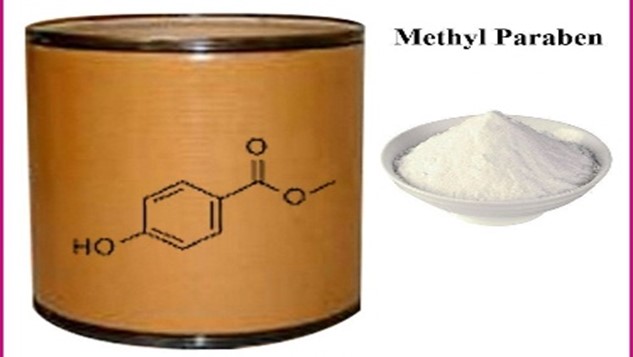
Fig-4: Methyl paraben
Rose Water [16]: -
Damask rose is botanically known as Rosa damascena Mill. It belongs to the Rosaceae family, a very popular family that contains many ornamental plants. Rose is a valuable and important main ingredient for fragrance and beautification. Phytochemical screening is helpful in the determination of bioactive metabolites that play their role in eliminating free radicals that not only affect the internal organs of the body by producing a variety of diseases but also affect the upper part of the body (skin). Are. We especially do the area which is in direct exposure to sunlight.

Fig-5: Rose water
HERBAL MATERIALS
Neem [15]: -
Neem Azadirachta indica is a tree belonging to the Meliaceae family. Bark, leaves and seeds are used to make medicine. Less frequently, roots, flowers and fruits are also used. Its leaves are used for contraception and abortion. Some people apply neem directly to the skin to treat head lice, skin diseases, wounds, and skin ulcers; as mosquito repellent; And as a skin softener. Neem is also used as a pesticide.

Fig-6: Neem
Lemon Oil [17]:-
Lemon essential oil has properties that may benefit human skin during environmental and chronological aging. The cleansing action of lemon essential oil soluble in grape seed oil may have practical applications in aesthetic medicine (a branch of medicine focused on satisfying patients' aesthetic desires and goals) for the treatment of human skin against oxidative damage. Therefore, frequent use of lemon essential oil may contribute to the prevention of lifestyle-related skin diseases by controlling the balance of oxidative stress.

Fig-7: Lemon oil
Aloe vera [18]: -
Aloe vera belongs to the Liliaceae family, and is commonly known as quargandal, aloe vera, ghikwar, katarazhai or kumari. It is widely used in medicines. With the improvement in cosmetology it has been proven that aloe vera is a very important ingredient of cosmetics. Cream containing aloe vera is beneficial for skin pimples and acne. Aloe vera gel has proven to be the best remedy for burns and wounds. In fact, the cellular regeneration, anti-bacterial and anti-fungal activities of aloe vera make it useful for skin rashes. Aloe vera also provides relief from itching and helps in treating ulcers. Aloe contains Vitamin B1, B2, B6, B12 and Vitamin C which provides a soothing and relaxing feeling to the skin.

Fig-8: Aloe vera
Krishna Tulsi [19]:-
Ocimum sanctum Linn., commonly known as Krishna Tulsi, is a tree in the Labiatae family. Ayurveda was primary in bringing to the attention of chemists the antimicrobial, antifungal, antibacterial and antioxidant components of Krishna Tulsi leaves for this natural and erect, herbaceous, much-branched, soft-haired, biennial or triennial plant 30-75 cm high. Most species have feathery green leaves.

Fig-9: Krishna Tulsi
Turmeric [20]: -
Curcuma longa (turmeric) is a plant in the Zingiberaceae family that is native to the South Asian region. Curcumin and other curcuminoids present in Curcuma longa have a variety of physiological and medicinal activities. Curcumin and other curcuminoids present in Curcuma longa have a variety of physiological and medicinal activities. The use of turmeric extract as both a topical and oral preparation for cosmetic or skin care products has been reported. It is claimed to be effective in treating skin aging, increased skin thickness and loss of elasticity, skin injury and other problems caused by sun exposure. Little experimental data exists to support these claims.
Fig-10: Turmeric

Fig-10: Turmeric
Method of Preparation [21, 22]: -
Preparation of extract – To prepare the extract, the dried plant material was subjected to aqueous maceration method for seven days. After seven days the decoction was filtered and concentrated to obtain a concentrated extract and stored in a desiccator until use.
- Melt the wax in a china dish on a hot plate.
- Liquid paraffin is added to it and then heated on a hot plate at 70?C.
- Borax was then dissolved in a 100 ml beaker and heated on a hot plate at 70?C.
- Both the oily and aqueous phases are heated.
- The beaker was kept at the same temperature i.e. 70?C and the extract was added.
- Now borax solution is slowly added to it.
- Add the melted wax solution drop by drop while stirring continuously.
- A few drops of rose oil are added to it for fragrance.
- It was stirred continuously until it cooled and a semi-solid mass was obtained.
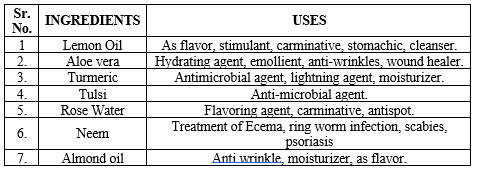
INGREDIENTS AND THAIR USES: -
EVALUATION: -
- PH [24]:-
Pharmaceutical stability studies involve the performance of a drug and its pharmaceutical properties in various forms. Rapid testing and pH-profile kinetics are the most important parts of chemical stability demonstration. pH is an important parameter as far as the effectiveness of the cream is concerned. The pH of human skin usually range from 4.5 to 6.0 and 5.5 is considered to be the average pH of the skin. Therefore, formulations intended for application to the skin should have a pH close to this range.

Fig.-12:- pH Test
-
Irritancy Test [25]:
Mark an area (1sq.cm) on the left hand dorsal surface. The cream was applied to the specified area and time was noted. Irritancy, erythema, edema, was checked if any for regular intervals up to 24 hrs and report.

Fig.-13:- skin Irritancy Test
-
Spreadability [26]:-
The spreadability of the formulation shall be determined by an apparatus consisting of a wooden block with a fixed glass slide and a movable glass slide, one end of which is tied to a weight pan rolled on a pulley with the fixed slide. Happens at horizontal level.
Spreadability (S) = M * L / T
Where,
M = weight tied to upper slide
L = length of glass slide
T = time taken to separate the slide completely.

Fig.14: Spreadability Test
- Acid value [27]: -
10 g of the substance was dissolved in 50 ml of a precisely weighed 50 ml mixture of equal volumes of alcohol and solvent ether, the flask was connected to a reflux condenser and heated slowly, until the sample was completely dissolved. Don't go. To dissolve, 1 ml phenolphthalein was added and titrated with 0.1N NaOH until it turned yellow. After stirring for 30 seconds a pink color becomes visible.
Acid value = n*5.61/w
Where,
n = the no. of ml of 0.1 N KOH solution.
w = the weight of substance in gram.
- Tests for microbial growth [28]:-
These tests were performed to determine microbial contamination of formulations prepared in agar medium. The prepared creams were inoculated onto plates of agar plate medium using the streak plate method and a control without cream was prepared. These plates were placed in the incubator and incubated at 37?C for 24 hours. After the incubation period, the plates were taken out and observed for microbial contamination compared to controls.

Fig.15: Microbial growth Test
-
Stability [29]:-
Stability testing of pharmaceutical products begins as a part of drug discovery and ends with the completion of the compound or commercial product to assess drug and formulation stability, stability studies were conducted as per ICH guidelines. Stability studies were conducted in accordance with ICH guidelines. The cream is bottled and stored in a humidity chamber at 40±2°C / 75±5% RH for three months. At the end of the study, the samples were analyzed for physical properties, pH and viscosity.
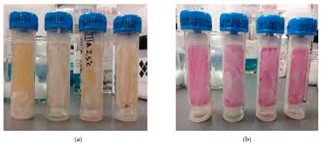
Fig.16: Stability Test
-
Viscosity[30]:-
The viscosity of the formulation was determined by a Brookfield viscometer. Viscosity measurements were performed using a Brookfield DV II+ viscometer using an LV-4 spindle. The developed formulation was poured into the adapter of the viscometer and the angular velocity was slowly increased from 0.5 to 20 rpm.

Fig.17: Viscosity Test
Marketed Product (31): -
- Himalaya Nourishing Skin Cream :-
With Aloe Vera and Winter Cherry, Himalaya's Nourishing Cold Cream for Women hydrates and moisturizes your dry skin to keep it non-greasy and light all day long. This is one of the best cold creams for women in India as it can be used on face and body. This best-selling cold cream for women protects your skin from pollution and dry weather, nourishes and moisturizes it.
- Brand: Himalaya
- Scent: Mild
- Special Ingredient: Aloe Vera, Winter Cherry
- Net Quantity: 200 mL
- Special Features: Skin Cell Regeneration, All-Day Moisturisation.

Fig.-18: Himalaya Nourishing Skin Cream
-
NIVEA Soft Light Moisturizer for Face and Body :-
Nivea Soft is one of the top cold creams for women. This best-selling cold cream is enriched with jojoba oil and Vitamin E to refresh your skin. High grade cold cream leaves a unique fragrance and makes it smooth, soft and healthy. The lightweight texture and fast-absorbing formula of this moisturizing cold cream makes it highly effective.
- Brand: Nivea
- Scent: Jojoba
- Special Ingredient: Glycerin, Jojoba Oil
- Net Quantity: 300 mL
- Special Features: Dermatologically Tested, Even and Smooth Application.

Fig-19: NIVEA Soft Light Moisturizer
-
Mamaearth Ubtan Nourishing Cold Winter Cream :-
This nourishing cold cream from Mamaearth is enriched with the goodness of turmeric and saffron which helps in moisturizing and softening the skin. The best-selling cold cream for women brightens and brightens your skin. The natural ingredients present in this nourishing cold cream give you fresh skin by reducing UV damage, making it one of the best cold creams for women in India.
- Brand: Mamaearth
- Scent: Ubtan
- Special Ingredient: Almond Oil, Vitamin E, Turmeric, Saffron
- Net Quantity: 200 mL
- Special Features: 100% Toxin-Free and ‘Made Safe’ Certified

Fig-20: Mamaearth Ubtan Nourishing Cold Winter Cream
-
Charmis Vitamin A, C, E Deep Nourishing Cold Cream:-
With its unique blend of Vitamins A, C and E, scientifically proven to combat the effects of pollution, Charmis Nourishing Cold Cream leaves skin naturally soft and supple. The unique blend of ingredients in this highly rated cold cream for women encourages the growth of healthy skin tissue. One of the best cold creams for women in India, it makes your skin beautiful and glowing.
- Brand: Charmis
- Scent: Light
- Special Ingredient:Steareth, Tetrasodium EDTA, Vitamin A, Vitamin C, Vitamin E
- Net Quantity: 200 mL
- Special Features: Smoothens Fine Lines on Skin, Suitable for All Skin Types
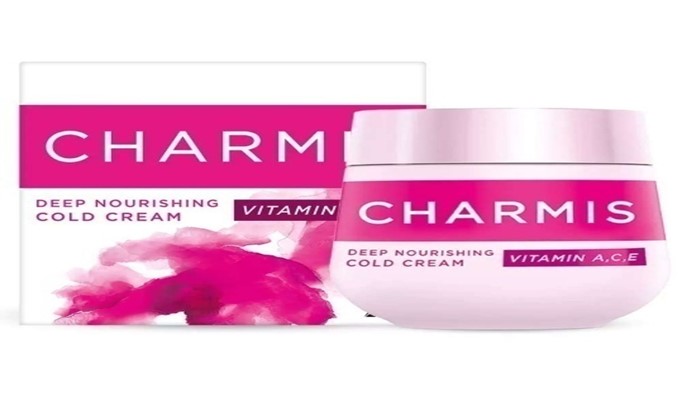
Fig-21: Charmis Vitamin Cold cram
5. POND'S Moisturising Cold Cream:-
With vital beauty oils and ten skin nutrients, this moisturizing cold cream prevents dry skin by making it soft and supple. This best cold cream for women works to give you softness from within, while you never have to worry about dry lines and patches.
- Brand: Pond’s
- Scent: Natural
- Special Ingredient: Glycerin, Cocoa Butter
- Net Quantity: 200 mL
- Special Features: Infused with 10+ Skin Nutrients

Fig-22: POND'S Moisturising Cold Cream
6. Parasoft Cream for Dry and Dehydrated Skin:-
Parasoft Cold Cream for Women contains a combination of Paraffins which are excellent moisturizing agents that nourish the skin from within. Due to its non-sticky formula, this highly rated cold cream penetrates deeply into the skin and provides intense moisturization leaving your skin soft and supple.
- Brand: Parasoft
- Scent: Aloe Vera
- Special Ingredient: Paraffin, Aloe Vera
- Net Quantity: 500 Grams
- Special Features: Quick Absorption and Instant Moisturisation
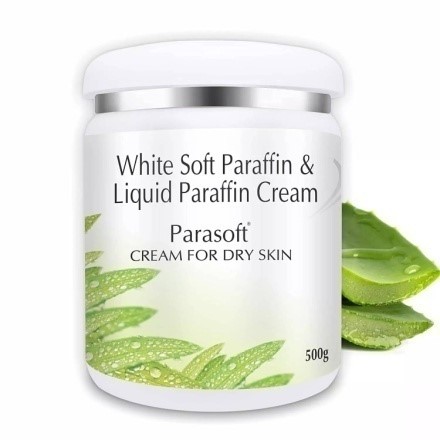
Fig-23: Parasoft Cream
7. Dabur Gulabari Moisturising Cold Cream: -
Dabur Gulabari is another well-known winter care cold cream, which contains natural ingredients. This cold cream enhanced with common rose oil and maintain the skin’s moisture balance, secure skin against skin harming components, remove dryness and bluntness and gives you a rose like brilliance.
- Brand: Dabur
- Scent: Gulabari
- Special Ingredient: Rose oil, turmeric, saffron (kesar).
- Net Quantity: 500 Grams
- Special Features: secure skin against skin harming components, remove dryness.
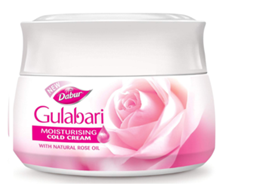
Fig-24: Dabur Gulabari Moisturising Cold Cream
CONCLUSION:-
The use of natural remedies in personal care products is becoming more popular as they are believed to have fewer side effects than synthetic products. As a result, the demand for herbal cosmetics in the market is increasing.
The created cream demonstrated good consistency and spreadability, homogeneity, pH, non-greasyness, and there was no phase separation during the research period, according to the aforementioned data. The purpose of cold cream is to moisturise dry skin and cool the body while also removing waste from pores and pores. It is simple to wet, wash, and put away. When used on the skin, they do not irritate. The skin receives additional conservation from the water phase.
REFERENCE
- Tejaswin D., Madhuri BP, Formulation and Evaluation of cold cream, IJCRT_ISSN: 2320-2882
- Anshul S, Maneesh B, jyoti G, Swati J, Formulation and evaluation of herbal cold cream, vol¬-9 Issue-3 2023, IJARIIE-ISSN9o0_2395-4396.
- Sundar M, suresh S, Linga KK., Preparation of cold cream against clinical pathogen using carallumaadscendens var. attenuata, vol 13, Issue 9, 2020, p.g. – 01.
- Akash S. Mali, Karekar P. Dr. Yadav A.V., Formulation and Evaluation of Multipurpose Herbal Cream, IJSR, vol. 4, Issue 11, Nov. 2015, ISSN: 2319-7064, p.g.-1497
- Jodand R., Prof. S.A. Ghadge, Dr. S. Jain, Formulation and evaluation of turmeric and aloe cold cream, IJNRD, Vol. 8, Issue 6 june 2023, ISSN: 2456-4184, p.g. – 1
- Shital V. Sirsat, Nikita M. Rathi, Anjali S. Hiwale and Punam B. Shelke, A review on preparation and evaluation of herbal cold cream, WJPR, vol. 11, Issue 5, 690-697, p.g. 2.
- Hani Yousef, Sandeep Sharma, Anatomy, skin (integuments), Epidermis, publishing 2-17 june.
- Roshan Y., Shiva KT, Rishabh P., Uma C., Arsh C., Himmat SC., “Pharmaceutical Preparation and Evaluation of Cold Cream, IJISRT, ISSN No. -2456-2165, Vol. -8, Issue-5, May -2023, (pdf 3).
- Varsha B., Abhijeet K, Ashish B, Dr. Alpana A, Dr. Gouri D., Formulation and Evaluation of Vitamin E Enriched Cold Cream with Almond oil as an Internal Phase, Int. J, ISSN 0976-044X, July-august 2020, article no. -11, Page no. -71-75, (pdf 11).
- Stefan Bogdanov ,Book of “Bees wax – History, Uses, Trade,april,,2016,
- F. Sharif, E. Crushell, K. O’Driscoll, B. Bourke, Liquid Paraffin: a reappraisal of its role in the treatment, Arch Dis Child, 2001;85: 121-124.
- Dr. Ramesh K. Goyal, Dr. Anita A Mehta, Dr. Gaurang B Shah, “Elements of Human anatomy & physiology & Health education “ B.S. Shah Prakashan, thirtieth edition; 2020-2021, page no. -275
- Dastapur Ashok Kumar, “Human Anatomy and Physiology”, Vallabh Prakashan, First edition 2021, p.g.- 42
- Nancy A. Monteiro- Riviere, “Structure and Function of skin” 2019
- https://www.researchgate.net/publication/235332343
- R. Chandrasekar, B. Sivagami, “Formulation and Evaluation of poly herbal skin care cream containing Neem and Tulsi “Research journal of topical and cosmetic science 9(1) 2013, ISSN _0976-2981, 2321-5844,
- Safia A, Najma S, Iqbal A, Zafar AM, “Photoprotective and antioxidant activities along with phytochemical investigation of Rose water”, International Journal Pharmaceutical science and Research (2018), vol. 9, Issue_12, ISSN_0975-8232: 2320-5148.
- G. Bertuzzi, B. Tirillini, p. Angelini, Venanzoni, “Anti oxidative action of citrus limonum essential oil on skin “ , European Journal of Medicinal plant 3(1), 1-9, 2013
- M. IMRAN QADIR “Medicinal and Cosmetological importance of aloe vera” International Journal of Natural Therapy 2009, vol. 2, p.p 21-26
- Puja S, Suprio D, Anupam S, “Formulation and Evaluation of Herbal Cream for Skin care using extract of Krishna Tulsi as active Ingredient with Anti-microbial activity”,
- Shahikuz Z, Naveed A, “Effect of Turmeric extracts Cream on Human Skin sebum secretion”, Tropical Journal of pharmaceutical Research (2013), ISSN-1596-5996,1596-9827
- Minimaran S. , Nithya , Praveen T K. , “Development and screening of Topical herbal cream Formulation for antibacterial and wound healing activity”, IJBPR,2014, 5(5), ISSN_0966-3651, 2229-7480.
- Harshada G, Ashvini G, Chaitrasudha G , prof. Kirti D, Dr. Rajesh O , “IJPRA vol. 7, Issue_ 4, july-aug 2022, ISSN_2456-4494
- Nicole G, Antje S, Ingo E, “Paraben as Preservatives in personal care products”, https://www.researchgate.net/publication/262068680
- Akhtar N. Khan BA, Khan MS, Mahmood T, Khan HMS, Iqbal M and Bashir S. , “ Formulation Development and Mosturising effects of a topical Cream of aloe vera extract, 2011, https://www.researchgate.net/publication/286481326
- Nirmal G, Aditi D, Pushpa P, Amit R, “Formulation and Evaluation of Herbal Fairness Cream Comprising Hydroalcoholic Extracts of Pleurotusostreatus, Glycyrrhizaglabra and Camellia sinensis. “ Uk Journal of Pharmaceutical and Biosciences, vol. 3 , 3(3), 40-45, 2015, ISSN_2347-9442
- Harshal S, Sharav D, Dhara P, Dhruvi P, Priyanka P, Snehal P, Kartik P, Chainesh S, “Formulation and Evalution of Topical Herbal Cream for Cellulitis, J Pharma Sci Bioscientific Res. 2016 6(4):584-593, ISSN NO. 2271-3681
- Chauhan L, Gupta S, Creams: A Review on Classification, Preparation Methods, Evaluation and its Applications, Journal of Drug Delivery and Therapeutics. 2020; 10(5-s):281-289 http://dx.doi.org/10.22270/jddt.v10i5-s.4430
- Siddiqua I. , Khatun U. , Ali S.N. , DR. Koneru A. ; Preparation and evaluation of Herbal cold cram with Incorporated longa, IJISRT, vol. 7,Issue 3, 2022,
- Soumya A., Rasheed S.H., Manjunath SY. , Formulation and evaluation ofherbal cold cream containing extract of MurrayaKoenigii and Cajanus Cajan, IJRPPS, 1(2),58-63.
- Matangu S.P., Aruna S., Gulsan MD., S.T.V. Raghavamma, Nadendla RR. , Formulation and Evaluation of Anti Aging Poly Herbal Cream, IJPS,24(2), Jan-Fab 2014,133-136.
- https://m.economictimes.com/top-trending-products/lifestyle/6-best-cold-creams-for-women-in-india-to-repair-dry-skin-starting-at-rs-154/articleshow/100636811.cms?utm_source=whatsapp_pwa&utm_medium=social&utm_campaign=socialsharebuttons


 Rahul kumar sahu* 2
Rahul kumar sahu* 2
 Bishesar Sahu 1
Bishesar Sahu 1























 10.5281/zenodo.11519811
10.5281/zenodo.11519811